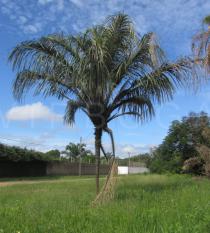Loading AI tools
Species of palm From Wikipedia, the free encyclopedia
Astrocaryum aculeatum (known in Brazilian Portuguese as tucumã, acaiúra, acuiuru, coco-tucumã, tucum, tucumã-açu, tucumã-macaw, tucum-açu, tucumaí-da-terra-firme, tucumãí-uaçu, tucumã-piririca, tucumã-purupuru or tucumã-do-mato[citation needed]) is a palm native to tropical South America and Trinidad.[1] It grows up to 15 m (49 ft) tall and is usually solitary. It has ascending leaves, erect inflorescence, and yellow fruit.
| Astrocaryum aculeatum | |
|---|---|
 | |
| Scientific classification | |
| Kingdom: | Plantae |
| Clade: | Tracheophytes |
| Clade: | Angiosperms |
| Clade: | Monocots |
| Clade: | Commelinids |
| Order: | Arecales |
| Family: | Arecaceae |
| Genus: | Astrocaryum |
| Species: | A. aculeatum |
| Binomial name | |
| Astrocaryum aculeatum G.Mey. | |
| Synonyms[1] | |
|
Astrocaryum tucuma Mart. | |
tucumã derives from tuku'mã in the Tupi language.[2]
Astrocaryum aculeatum was first described by German botanist Georg Friedrich Wilhelm Meyer in 1818 based on a specimen from the Essequibo River in Guyana.[3]
Astrocaryum aculeatum is found in and around the Amazon Basin, from Trinidad and Tobago in the north, through Venezuela, Guyana, Suriname, the Brazilian states of Acre, Amazonas, Pará, Rondônia, Roraima and south through the Bolivian departments of Beni, Pando, Santa Cruz.[4]
This plant has edible fruit which may be used for making a kind of juice.[5] It is also used to make a symbolic ring called a tucum ring.
A fiber is extracted from the leaves for making hammocks and ropes that resist salt water.[2]

The fruit of tucumã is composed of a woody core almost black in color, containing the white paste of the seed (colloquially called an almond in Brazil) and covered with a yellow-orange pulp. Two types of oils are produced from this fruit: the oil of the external pulp and the almond oil.[6]
The oil extracted from the pulp contains 25.6% saturated fatty acids and 74.4% unsaturated fatty acids composed of palmitic, stearic, oleic, and linoleic acids. It can be used as an emollient. The value of beta-carotene (which is 180 to 330 milligrams/100g oil) is more concentrated in the oil than in the pulp.[7]
| Fatty acid composition of the oil Tucumã (Pulp) | |
|---|---|
| Palmitic | 27,7% |
| Oleic | 65,67% |
| Linoleic | 3,65% |
| Linolenic | 4,97% |
The tucuma pulp oil could in the future be used to manufacture soap, body lotions or hair care products.[7]
Physico-chemical data
| Index | Unity | Reference values |
| Free fatty acids | % | 1.4562 |
| Refractive Index | - | 1.4562 |
| Index of Iodine | gl2 / 100g | 82 |
| Saponification value | mg KOH / g | 188.4 |
| Materia unsaponifiable | % | 1,4 |
| Acidity | mgKOH / g | 2.58 |
| Index of Peroxide | meq / kg | 1.72 |
| Density | g / L | 0.982 |
| Melting | °C | 27-35 |
Seamless Wikipedia browsing. On steroids.
Every time you click a link to Wikipedia, Wiktionary or Wikiquote in your browser's search results, it will show the modern Wikiwand interface.
Wikiwand extension is a five stars, simple, with minimum permission required to keep your browsing private, safe and transparent.